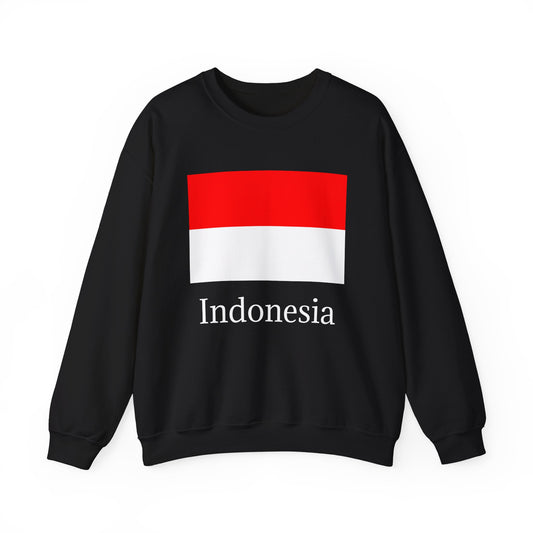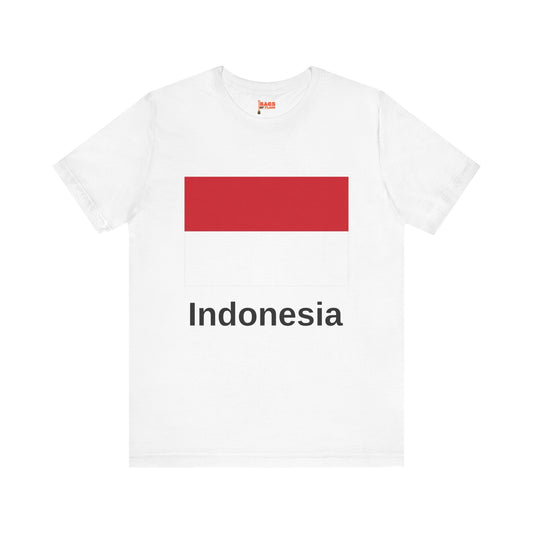-
Indonesia Flag Sweatshirt
Regular price $34.15 USDRegular priceUnit price / per -
Indonesia Leather Patch Hat
Regular price $18.85 USDRegular priceUnit price / per -
Indonesia Sweatshirt
Regular price $34.15 USDRegular priceUnit price / per -
Indonesia Hoodies
Regular price $34.40 USDRegular priceUnit price / per -
Indonesia T-shirts
Regular price $22.79 USDRegular priceUnit price / per -
Indonesia Flag Hoodies
Regular price $34.40 USDRegular priceUnit price / per -
Indonesia Flag on T-shirt
Regular price $22.79 USDRegular priceUnit price / per
Collection: Indonesia
The Indonesian flag, Sang Saka Merah Putih, is significant in the country's history and culture. We will delve into the unique facts and details surrounding the flag's design, symbolism, historical context, and current relevance.
Overview of the Indonesia Flag

The flag of Indonesia, a striking emblem of national identity, is characterized by its simple yet profound design of two equal horizontal bands. The upper band is painted in a vivid red, while the lower band is a pristine white. This bicolor flag, devoid of intricate symbols or emblems, conveys a powerful message through its color choice and composition. The flag's dimensions are unique, with its width-to-length ratio set at 2:3, distinguishing it from many other national flags.
This straightforward design symbolizes the Indonesian ethos of bravery and purity and serves as a reminder of the country's struggle and triumph over colonial domination. Its bold colors are meant to stand out, reflecting the nation's resilience and peaceful aspirations. As a symbol that unites the Indonesian archipelago, the flag transcends linguistic, ethnic, and cultural differences, embodying the national motto, "Bhinneka Tunggal Ika" (Unity in Diversity). Through its simplicity and meaningful color scheme, this flag continues to inspire a sense of patriotism and solidarity among Indonesians.
Historical Context

The historical journey of the Indonesian flag is interwoven with the nation's struggle for independence and identity. Officially adopted on August 17, 1945, it emerged as a powerful symbol amid the enthusiasm for liberation from Dutch colonial rule. This date is significant for the flag's adoption and marks Indonesia's declaration of independence, a day that heralded a new era for the Indonesian people.
Designed by Soekarno, who later became the country’s first President, the flag's inception is a tale of resilience and determination. Its design has stood the test of time, remaining unchanged over the decades, a testament to its enduring significance and the unyielding spirit it embodies. The moments following its first hoisting were charged with emotion and patriotism, signaling the beginning of Indonesia's journey as a sovereign nation.
The flag's adoption was more than a ceremonial act; it was a declaration of unity, sovereignty, and the dawn of a new national identity. It represented a clean break from the past and a collective aspiration for the future. The red and white banner flew as a beacon of hope and freedom, rallying the Indonesian people together under a common cause during the pivotal moments of their history.
This emblem of independence has since been a constant in Indonesia's national narrative, woven into the fabric of its society and governance. It serves as a daily reminder of the sacrifices for freedom and the ongoing journey toward unity and peace.
Symbolism Behind the Flag
The vibrant colors of the Indonesian flag are laden with profound meanings that resonate deeply within the nation's heart. The red band, positioned at the top, is a powerful emblem of human blood, symbolizing the Indonesian people's courage, human spirit, and sacrifice in their relentless fight for independence. It is a tribute to the bravery exhibited during their struggle against colonial powers, and the battles fought to forge a sovereign nation. Beneath the red lies the white band, a stark representation of purity and the spiritual aspect of life.
This color embodies the nation's aspirations for peace and honesty, guiding the people's moral compass toward unity and righteousness. Together, these colors not just delineate the Indonesian flag; they weave a narrative of resilience, hope, and the unyielding pursuit of freedom. Each time the flag is hoisted, it is a reiteration of the country's foundational principles, echoing the ancestors' dreams for a future marked by unity in diversity and a shared commitment to the nation's ideals. The duality of these colors encapsulates the essence of Indonesia's national identity, reminding its citizens of their collective history and the enduring values that define their path forward.
Current Relevance
Today, the Indonesian flag continues to hold a pivotal place in the nation's heart, frequently seen at the forefront of national celebrations, governmental ceremonies, and military events, symbolizing the unity and shared identity of the Indonesian people. Recently, its presence has extended beyond traditional settings, becoming a central element in social and political movements, as citizens wield the flag to express national pride or voice collective concerns. The flag’s significance is deeply ingrained in the Indonesian consciousness, making it a powerful symbol of the nation’s sovereignty and enduring spirit.
Despite its revered status, debates have emerged around the proper etiquette for flag handling and the contexts in which it should be displayed, reflecting a broader conversation about national identity and respect for state symbols. These discussions underscore the flag’s relevance in contemporary Indonesian society, highlighting its role as a historical artifact and a living symbol of the nation's values, aspirations, and ongoing quest for unity.
Additional Facts
In a tradition steeped in reverence, the national flag is ceremonially hoisted at the Presidential Palace in Jakarta, symbolizing the start and end of each day. This ritual underscores the flag's paramount importance in Indonesian life and governance. Across the nation, citizens are expected to pause and pay homage during the flag-raising ceremony, reinforcing the sense of national unity and pride. A lesser-known protocol dictates that the flag, as a symbol of the nation's sovereignty and dignity, must always be displayed in pristine condition, free from damage or desecration.
In national mourning, the flag is the only emblem authorized to be flown at half-mast, a solemn acknowledgment of grief shared by the entire nation. Interestingly, the flag's distinct design, deviating from the more common rectangular shape, sets it apart globally, highlighting Indonesia's unique identity and heritage. These protocols and practices not only preserve the flag's symbolic value but also foster a collective respect and admiration for the nation's emblem.














